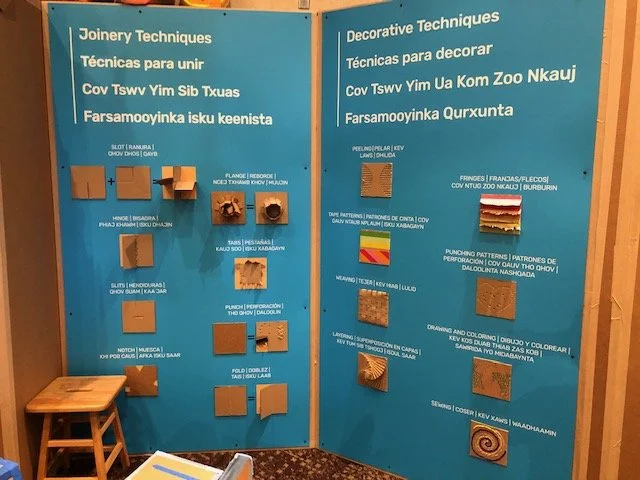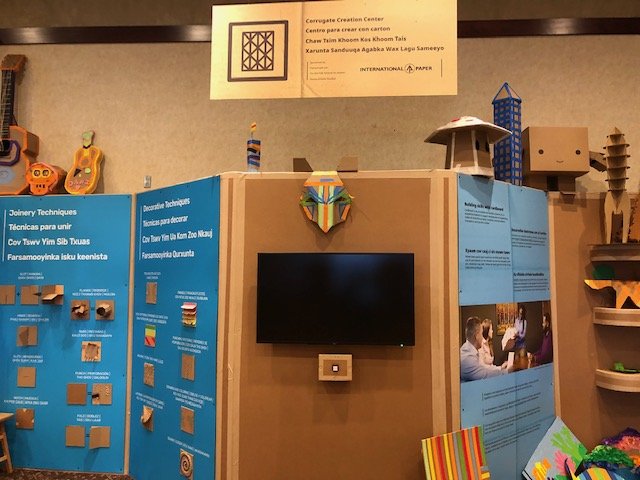Cardboard City
An exhibit at the Science Museum of Minnesota, providing opportunities that invite and support engineering - related habits of mind, created with the unique Twin Cities community in mind.
Overview
Role
Exhibit Developer
Timing
2019 - 2022
Challenge
How might we create structured, inclusive, and informal engineering-related learning experiences using an accessible material - cardboard? How might we expand the number and kinds of museums and participants who engage in engineering-related experiences?
Outcome
A whimsical and inspirational exhibition at the Science Museum of Minnesota (Summer 2021 and 2022) offering opportunities that invite and support engineering-related habits of mind (systems thinking, creativity, collaboration, building, testing, etc) with familiar materials and tools.
Impact
1. The museum’s first exhibition with copy in four languages: English, Spanish, Hmong, and Somali.
2. Museum-wide signage redesigned with the Twin Cities community in mind.
3. The exhibit’s successes informed part II of the project: A guide to creating makerspaces across the country
Related Content
Background
Cardboard events at the Science Museum of Minnesota have been a hit with museum visitors since 2012. Every other year, visitors have had the opportunity to build with this familiar material in an open-ended format. However, in 2019 the Science Museum of Minnesota received funding from the National Science Foundation (NSF) to research how youth participants develop engineering habits in a structured environment.
Ideation & Development
The design process started with a kickoff workshop with the STEM Education department to understand what curriculum had already been developed around engineering and cardboard and how we could scale to a full scale exhibit. From the information collected at the workshop, I identified a number of programs that had exhibit potential. Then narrowed down the list even more based on considerations for the visitor exhibit experience and project goal: The experience should enable a diverse group of visitors to develop skills and confidence in fundamental engineering abilities. Other design accessibility considerations I kept in mind during development include ADA compliant table height, tools, and small parts choking hazards.
The next challenge was: How do we create thematic, imaginative connections that would make the exhibit more engaging and relevant? What better way than to frame it as an immersive Cardboard City with various clusters that make it a community.
While we agreed upon the city design direction, one idea I really wanted to try out with visitors was a community build. Visitors would have the opportunity to create a community element and add it to the growing Cardboard cityscape. We reached a reasonable conceptual state. So my team and I invited museum staff to see our progress. At this all-day event, we shared our tentative idea and asked for their feedback.
Based on the event feedback and smaller scale testing with visitors, we were ready to make the changes and scale them up into higher-fidelity prototypes…but only a few weeks later, COVID arrived and everything changed. Nearly a year later, we resumed work. Now I had to consider health guidelines and how that would affect the overall exhibit experience. Touchpoints and airflow became focal to every design decision. However as more research about COVID transmission was published, we relaxed certain precautionary measures that ended up enhancing the visitor and staff experience.
Copywriting
Minneapolis-St Paul is home to a vibrant Hmong and Somali population. As part of our mission to create museum experiences more accessible to our community, I advocated for this being a learning opportunity to walk the talk and see how we can produce copy in four languages. I have visited various museums across the country and thought if they could do it, why can’t we? I felt this was a great opportunity to deliver on the project directive to “build a more inclusive makerspace” by understanding who is in our immediate community. Given how much space it can take up on graphic panels, I made it a priority to produce copy that was short, concise, and as culturally relevant as possible. I then collaborated with human translators and colleagues to obtain appropriate translations.
Launch
Creating a successful museum exhibit requires a lot of time, effort, and collaboration. Shout out to all the museum staff that shared their craftsmanship and artistry in supporting the exhibit by producing amazing cardboard structures. Their work made for a more inspirational and immersive exhibition than I could have imagined.
Impact
Museum-wide signage redesigned with the Twin Cities community in mind.















